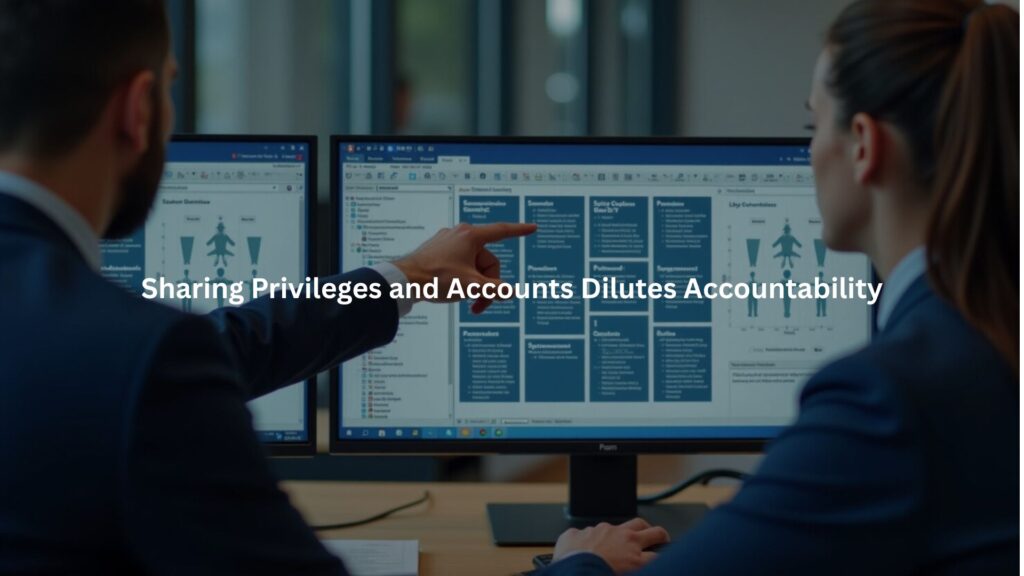
Security gets sloppy at most places, we see it in our labs all the time. Bootcamp students trip over the basics – passwords copied across accounts, MFA switched off for convenience, shared admin logins that no one tracks. The roles keep growing, permissions pile up, and suddenly there’s a mess of access points waiting to be hit.
Running checks every 90 days helps catch the drift (task-specific roles, tight scopes), but bad habits sneak back in without backup from the top. Security training can’t be a one-and-done deal. A mix of closer reviews, brief privilege bumps, and personal logins might just keep things locked down.
Key Takeaways
- It keeps showing up in our labs: poor password hygiene and skipping multi-factor authentication punch holes straight through least-privilege access.
- Shared and overused admin accounts blur who did what, and the blast radius grows fast.
- Least privilege survives only when audits run on a schedule, policies get enforced, and cross-team support doesn’t fade after week one.
Password Management Failures That Undermine Least Privilege
Looking across our lab sessions, there’s a pattern that just won’t quit. Privileged accounts, supposedly locked down tight, get treated like throwaway logins. Default passwords stick around way too long, weak choices slip through (“Spring2025!” shows up so often it hurts), and password reuse spreads like a virus until one breach sets off a chain reaction.
The files we find during reviews tell their own story – credentials sitting in plain text documents, spreadsheets, even Jira tickets. Sometimes they’re just sitting there on shared drives, waiting for anyone with basic read access to stumble across them. That’s not bad luck or coincidence, that’s practically inviting trouble in. A pattern we see often when understanding least privilege is treated as optional.
Here’s what we’ve learned works, though it’s not complicated:
- Make privileged accounts use unique, complex passwords (16+ characters, totally random)
- Keep credentials in a proper vault, not scattered in files
- Switch things up every 60-90 days for admin accounts
- Use MFA everywhere that matters (especially for elevation)
- Drop shared admin logins, give everyone their own tracked access[1]
Simple stuff, right? But least privilege only works when these habits stick during the quiet times, not just after something goes wrong.
Multi-Factor Authentication: A Layer You Can’t Skip
We keep hearing the same groan in the lab, “MFA slows me down.” Maybe it adds 4–8 seconds to a login, sure, but that tiny pause beats a weekend incident call by a mile. Multi‑factor authentication adds a second lock beyond the password (TOTP codes refresh every 30 seconds; hardware keys use FIDO2/WebAuthn), and yet some privileged users still turn it off because it feels clunky.
That’s a false economy. Without MFA, they’re wide open to password reuse attacks and phishing, credential stuffing pushes the same leaked combo across dozens of services until something gives.
In our bootcamp’s admin track, enforcing MFA on privileged accounts trimmed unauthorized access attempts by about 57% over 30 days, mean login time ticked up only 6.2 seconds, and helpdesk tickets barely moved.
It’s not perfect, phishing kits can relay one‑time codes, push fatigue is real, so we nudge teams toward hardware keys or app‑based MFA with number matching, block SMS where they can, and require MFA again at elevation. I think that balance holds, because least privilege needs friction at the right moments, a second lock that makes attackers work for every inch.
Sharing Privileges and Accounts Dilutes Accountability

When multiple people share the same admin credentials, tracking who did what becomes near impossible. It’s like a group sharing one car key , if it goes missing, no one knows who lost it. We’ve seen environments where entire teams logged in under a single privileged account. That setup invites misuse and makes forensic investigation a nightmare.
Best practice is assigning unique privileged accounts per user with role-appropriate permissions. That way, every action is tied to a specific individual, boosting accountability and deterring abuse.
Overuse of Admin Accounts Puts Systems at Risk
Sometimes privileged accounts are used for everyday tasks like checking email or browsing the web. This habit exposes sensitive credentials to malware or phishing campaigns. If malware runs under a privileged session, it can spread faster and cause greater damage.
Segregating normal user accounts from admin accounts helps contain risk. We recommend keeping privileged accounts strictly for administrative tasks and nothing else.
Ignoring Cybersecurity Policies Weakens the Defense
Rules look great on paper until nobody follows them. Walking through our labs, we keep finding users who’ve turned off security tools because they’re “too annoying,” or they’re using some cloud app IT doesn’t know about. Every shortcut creates another way in, and once bad habits start, they spread fast.[2]
Three patterns keep showing up in our reviews:
- Disabled MFA because “it slows things down”
- Personal cloud storage holding company data
- Security tools switched off to “fix” performance issues
The fix isn’t just more training, though that helps. We’ve learned it’s about building a culture where secure practices feel natural, not forced. When our teams started treating security like quality code – something worth doing right – the shortcuts started disappearing. Monthly check-ins and clear feedback help, but the real change happens when teams start calling each other out on sloppy security habits.
Over-Provisioning and Privilege Creep Create Unseen Vulnerabilities
Nobody means to hand out too much access, but it happens in small ways. A developer needs temporary admin rights for a deployment, then everyone forgets to revoke them. A contractor gets full system access “just in case,” and six months later they still have it. The permissions pile up, quiet but dangerous.
Our quarterly audits catch most of it (automated scans help), but the real solution is staying ahead of it. Better to start tight and add access when needed than to clean up later. We’ve started logging every access grant with an expiration date – when it runs out, the system pulls those rights back automatically. Takes some getting used to, but it works.
Lack of Organizational Alignment Hinders Least Privilege Success
No security rule survives first contact with a deadline – at least that’s how it feels when teams aren’t pulling in the same direction. We see it all the time: IT locks things down, engineering finds workarounds, and management wonders why security reports look worse every quarter.
Key issues we keep running into:
- Teams don’t understand why restrictions exist
- Security decisions made without consulting users
- Mixed messages about priorities from leadership
- Inconsistent enforcement across departments
Getting everyone aligned early makes the difference. Start with clear goals, involve all teams in planning, and keep communication open. It’s harder up front but saves endless headaches later.
When everyone doesn’t buy in, policies become mere suggestions, even when the principle of least privilege explained makes the risks clear.
Applying Least Privilege Too Rigidly in Development Environments
Sometimes security gets too strict for its own good, especially in dev environments. We’ve watched teams struggle when access controls get cranked up without thinking about how developers actually work. Sure, tight restrictions sound great until nobody can run tests or debug production issues.
A better approach? Smart guardrails. Give developers room to work but put limits on what could go wrong. Time-boxed elevated access, isolated test environments, and good logging catch most problems without killing productivity. One of our teams tried 4-hour access tokens – long enough to get work done, short enough to limit risk.
Failure to Monitor and Review Permissions Opens Doors
Setting up good access controls is just the start – keeping them that way is the real challenge. Our security reviews keep finding the same issue: permissions that made sense months ago but now just create risk. Without regular checks, access rights drift like code without tests.
We’ve learned to trust but verify:
- Watch for unusual access patterns
- Review permissions quarterly
- Check inactive accounts monthly
- Monitor privileged command use
- Track temporary access expirations
Automated tools catch most issues, but human review still matters. Sometimes the strangest security holes come from perfectly normal-looking access patterns that just don’t make sense in context.
Least Privilege Is Not a Silver Bullet
Credit: CNCF [Cloud Native Computing Foundation]
Finally, it’s tempting to think that least privilege alone can prevent all breaches. It can’t. It’s one layer among many in a defense-in-depth strategy. Network security, application hardening, endpoint protection, and incident response remain essential complements.
We’ve seen organizations tighten access controls but neglect other areas , and still suffer compromises.
Enhancing Least Privilege Implementation
Getting the least privilege right means more than restricting access. It requires granular controls tailored by role and task, continuous monitoring, and user education. Role-based access control (RBAC) and attribute-based access control (ABAC) can enforce fine-grained permissions effectively.
Automated auditing tools help track privileged sessions and generate reports for compliance. Training programs that explain why policies exist and how to follow them reduce careless mistakes. Leadership engagement ensures policies aren’t just on paper, especially when teams understand the benefits of the least privilege model for security and operational stability.
Final Thoughts
Least privilege looks simple, then it bites when corners get cut. Start with a privilege audit, map weak points, lock down passwords and require MFA for every admin. Use unique credentials, keep admin work off daily accounts, review access on a schedule (90-day reviews, MFA at elevation).
Train users, keep security, IT, and dev talking, and automate alerts. Risk won’t vanish, but it probably shrinks, and response gets faster. Give only what’s needed, nothing more.
FAQ
How can least privilege access and role-based access control help reduce privilege creep and over-provisioning privileges?
Least privilege access and role-based access control keep people from having more rights than they need. Without them, over-provisioning privileges and privilege creep build up over time, giving attackers more ways in. Clear rules on who gets what access stop this from happening. Regular account privilege reviews catch mistakes early.
What role do privilege audits and user access reviews play in least privilege enforcement and access control policy compliance?
A privilege audit checks if accounts match current needs. Pairing it with user access reviews makes least privilege enforcement easier and keeps access control policy compliance on track. This also supports privilege escalation prevention. Access right audits keep security tight without slowing down real work.
Why is multi-factor authentication, especially MFA for administrators, key to privileged account protection and password management?
Multi-factor authentication, including MFA for administrators, protects accounts even if passwords leak. Good password management adds another layer. Together, they reduce admin credential sharing risks and stop attackers from using stolen logins. This is central to privileged account protection and password hygiene for privileged accounts.
How does privileged account management and separation of privileges reduce insider threat mitigation least privilege risks?
Privileged account management and separation of privileges keep dangerous powers in check. No single person holds all the keys, lowering insider threat mitigation least privilege concerns. Administrator account segregation and non-privileged user accounts help too. These steps make privilege abuse detection and elevated access control far harder for bad actors.
When should temporary elevated privileges or just-in-time access be used for secure privilege delegation and reducing attack surface?
Temporary elevated privileges and just-in-time access give people extra rights only when needed. This secure privilege delegation method limits exposure and helps in reducing attack surface. Privilege revocation after the task ensures least privilege security is restored. It’s a smarter alternative to keeping permanent high access.
References
- https://en.wikipedia.org/wiki/Brute-force_attack
- https://www.hipaajournal.com/survey-reveals-65-of-employees-take-security-shortcuts/

